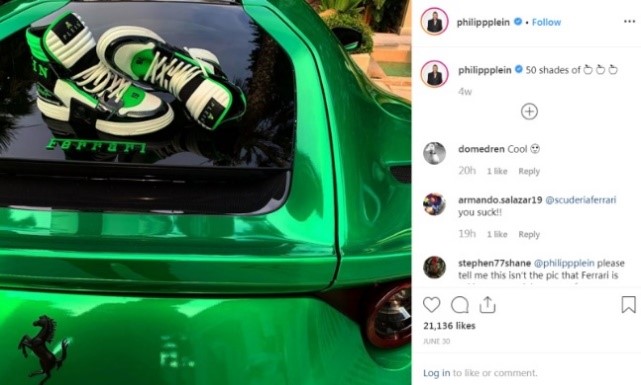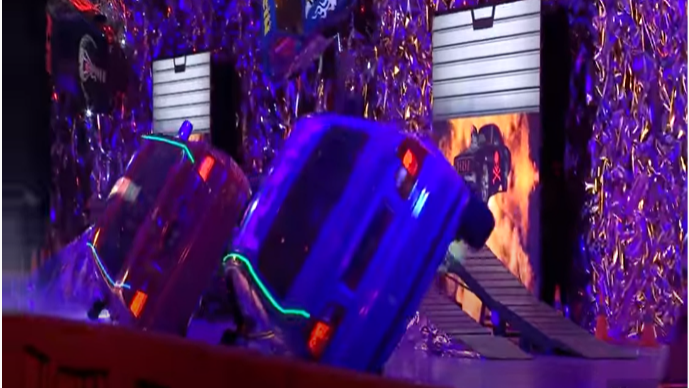Don’t mess with Ferrari: the Prancing Horse legal drama
Use of Ferrari’s trade mark in a fashion show or on social media requires consent. This is the lesson we assume Philipp Plein has recently learnt following a couple of legal defeats before the Italian Courts that ruled in favour of Ferrari.
In a ruling issued by the Court of Genova last June, the Court ruled in favour of Ferrari for the illegitimate use of Ferrari’s trade marks on Plein’s Instagram account. The designer on that occasion posted several pictures as well as Instagram stories showing some of his clothing line with Ferrari’s trade marks in the background. Ferrari successfully argued that in those shots Philipp Plein was unlawfully appropriating the positive image and reputation of the well-known car company by using its trade marks for promotional purposes.

In another recent case, the Court of Milan ordered Plein to remove from its website, social media, and other online platforms all the videos and images showing Ferrari cars and trade marks. The Court also ordered the payment, in favour of Ferrari, of €300,000 in damages plus legal fees as well as the publication of the decision in two national newspapers. Furthermore, in the event in which that Philipp Plein would not promptly remove the contested images and videos representing Ferrari cars and trade marks, it will have to pay a penalty of €10,000 for each day of delay in the removal of the infringing images and videos. To view the decision, click here.
Background
In June 2017, at the 2018 S/S Philipp Plein fashion show, the German designer used some Ferrari cars – that featured during the runway show – on which Plein’s drawings and trade mark were affixed.

In light of the above, the Ferrari legal team claimed an infringement of article 9, par. II, letter c) EU Reg. 2017/1001 as well as of article 20, paragraph I, letter c) of the Italian Code of Intellectual Property for the illegitimate use of its trade mark made by the Swiss fashion house.
In its defence, Plein argued that such use of Ferrari brand cars occurred in a very peculiar context that had entertainment purposes only. Indeed Plein outlined that the runway show evoked the atmospheres of famous films such as Grease, West Side Story and Fast and Furious. Furthermore, Philipp Plein stressed that also cars produced by others manufacturers, such as Lamborghini, BMW and AUDI, as well as several motorbikes, featured in the runway show. Therefore, such use had no actual or potential risk to associate the above-mentioned brands with the designer’s haute couture creations. In that regard, the defendant invoked the application of the principle of exhaustion of the trade mark referred to in article 15 EUTMR and article 5 of the Italian Code of Intellectual Property, rejected by the Court.
Legal Analysis
The Court of Milan outlined that the analysis of the images provided by Ferrari showed that its cars were decorated with Philipp Plein’s distinctive signs causing the association between the two trade marks. Furthermore, such images have been published on the web for advertising purposes since Plein gave a particular emphasis on the various luxury vehicles used for the runway show. According to the judges, the affixing of logos and inscriptions that were distinctive signs of Philipp Plein, prove the conscious association between the plaintiff’s trade mark and the products marketed by the defendant. Therefore, the provisions set forth in article 9, par. II, letter c), EU Reg. 2017/1001 and article 20, par. I, letter c) of the Italian Code of Intellectual Property applied.
The Court also highlighted that Ferrari is a well-known brand with a strong reputation and, therefore, it enjoys the specific protection that is recognised to well-known brands by Italian law.
Procedural Considerations
A couple of procedural elements appear relevant to this case.
- Amount of damages – damages were calculated based on copyright royalties paid by the defendant for music and other works used as part of the same show, rather than on previous Ferrari’s trade mark licence fees. The Court considered such criterion suitable to the facts of the case, as the licence agreements filed by Ferrari were considerably redacted and, as a result, the licensed rights were unclear and, in any event, more extensive than the rights infringed by Plein. As a result, the court granted €300,000 in damages against the €2 million claimed by Ferrari.
- New facts and refund of legal fees (occurred during negotiations) – it appears that these claims were submitted by Ferrari after the deadline and therefore additional sums were not considered by the court.
Conclusions
Lots of learning points appear from this case.
If there still was any doubt, use of a proprietary trade mark on a third party product, featuring marks with reputation constitutes an infringement, regardless of use of multiple third parties’ brands (which effectively constitute infringement of those brands as well) or the context in which such use took place (e.g. “a show inspired by”).
Although infringement cases based on marks with reputation may appear straightforward from an evidence standpoint, considerations regarding determination of damages should take place early on in the procedure before Italian courts, as strict deadlines apply.
Lastly, if a trade mark owner wishes to have previous licences considered by courts, the context of such licences is key to argue the type of brand the owner is willing to collaborate with and the terms, including royalties, that the trade mark owner would have obtained if a licence was granted to the infringer.
By Serena Totino and Eleonora Curreri
